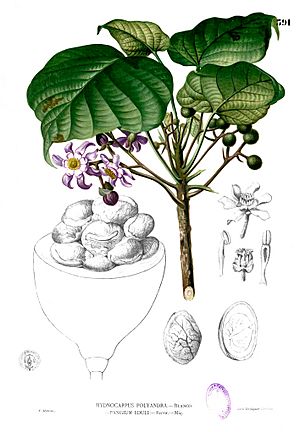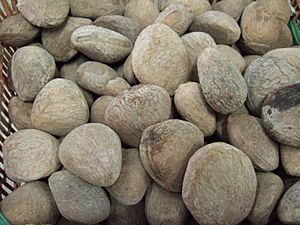Pangium facts for kids
Quick facts for kids Pangium |
|
|---|---|
 |
|
| Plate from book: Flora de Filipinas | |
| Conservation status | |
| Scientific classification | |
| Genus: |
Pangium
|
| Species: |
edule
|
| Nutritional value per 100 g (3.5 oz) | |
|---|---|
| Energy | 462 kJ (110 kcal) |
|
23.9 g
|
|
| Sugars | 14.1 g |
| Dietary fiber | 6.2 g |
|
2 g
|
|
|
Protein
|
2.3 g
|
| Vitamins | Quantity
%DV†
|
| Vitamin A equiv.
beta-Carotene
|
2%
19 μg
2%
230 μg |
| Vitamin C |
31%
25.8 mg |
| Minerals | Quantity
%DV†
|
| Calcium |
2%
15 mg |
| Iron |
17%
2.2 mg |
| Magnesium |
9%
32 mg |
| Manganese |
7%
0.155 mg |
| Phosphorus |
7%
52 mg |
| Potassium |
5%
151 mg |
| Sodium |
0%
4 mg |
| Zinc |
5%
0.43 mg |
|
Link to USDA Database entry
|
|
| †Percentages estimated using US recommendations for adults. | |
Pangium is a genus containing the sole species Pangium edule, a tall tree native to the mangrove swamps of Southeast Asia (Indonesia and Papua New Guinea). It produces a large poisonous fruit (the "football fruit" or pangi) which can be made edible by fermentation. It is dioecious, with male and female flowers produced on separate individuals.
The taxonomy of the tree is uncertain and it may also be classed in the Flacourtiaceae or the Violales.
Contents
Description
The tree can reach 18 metres (59 feet) in height. The leaves are heart-shaped. The brownish fruit grows in clusters and shaped like a pear.
Cultivation
The tree requires many years to mature and the seeds are therefore most frequently harvested from wild trees, as it is not economically feasible to cultivate. Although poisonous to humans, the seeds of the tree form part of the natural diet of the babirusa (Babyroussa babyrussa).
Uses
The fresh fruit and seeds contain hydrogen cyanide and are deadly poisonous if consumed without prior preparation. The seeds are first boiled and then buried in ash, banana leaves and earth for forty days, during which time, they turn from a creamy white colour to dark brown or black. The method relies on the fact that the hydrogen cyanide released by the boiling and fermentation is water-soluble and easily washed out.
The kernels may be ground up to form a thick black gravy called rawon, popular dishes include nasi rawon, beef stew in keluwek paste, popular in East and Central Java, and sambal rawon, rawon stew made with beef or chicken also exists in East Java. In West Java and Jakarta, gabus pucung or snakehead fish in pucung paste soup is a popular traditional dish in Betawi cuisine. The Toraja dish pammarrasan (black spice with fish or meat, also sometimes with vegetables) uses the black keluak powder. In Singapore and Malaysia, the seeds are best known as an essential ingredient in ayam (chicken) or babi (pork) buah keluak, a mainstay of Peranakan cuisine. Dusun tribe from Borneo use this pounded kernel as main ingredient for making local signature dish called bosou, sour taste fermented fish.
People of Minahasa tribe in North Sulawesi use young leaves as vegetable. The leaves will be sliced into small part then it is cooked by mixing with herbs and pork fat or meat inside bamboo. Many sellers in Tomohon traditional market sell the leaves whether sliced or not.
Nutrition
The edible portions of the plant are an excellent source of vitamin C and high in iron.
See also
 In Spanish: Pangium para niños
In Spanish: Pangium para niños



